The Witcher 3 Review
Introduction
The biggest RPG release of 2015 is finally here! We’ve been waiting almost exactly four years for it, as The Witcher 2 was released to high acclaim on the 17th of May 2011. We’ve been more or less bombarded with hype for quite some time now, so how does the actual game compare to all the hype?
Very well, I’d say. The Witcher 3 is quite an experience. While there will be criticism in this review, and with good reason (I was somewhat frustrated at times, and almost managed to destroy my keyboard on one occasion), I still feel that it is one of the best games to come out in years, and probably the first to really get storytelling right in such a massive, open world.
That approach differs somewhat from The Witcher 2, which was more of a story driven RPG with some semi-open areas than an open world RPG in the style of Skyrim. Certain things remain the same or at least similar though:
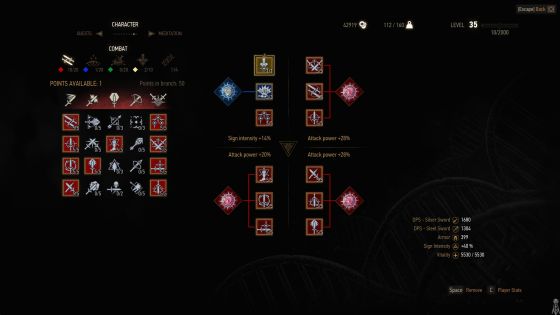
- Character development: Geralt is still a Witcher, and as such he’s still got access to swords, signs and alchemy. In The Witcher 2 it was fairly easy to get to the top of 2 out of 3 talent trees, which is not the case in The Witcher 3, but on the other hand it’s also less needed. The top talents in The Witcher 2 were mandatory for any good build; in The Witcher 3 it’s entirely possible with a "mix & match" approach, depending on your style of play. Another difference is that most abilities and signs have an "alternate version" near the start of the talent tree, which enables Geralt to use said ability in a slightly difference way. This only makes a minor difference for melee or alchemy oriented builds, but it’s quite significant for players focusing on signs.
- Combat: The combat is very similar to that of The Witcher 2, albeit with a bit more pace in The Witcher 3. Personally I prefer the version found in The Witcher 2, as it struck what I consider to be an almost perfect balance between being action packed and tactical. The Witcher 3 is a bit too fast paced for that, but this is clearly about personal preference. At least there are no QTEs in The Witcher 3, which is a relief.
- Controls: The controls are more or less the same as in The Witcher 2, so anyone who played it will feel right at home. On a keyboard + mouse setup it does feel slightly less tuned though, probably because they’ve spent more time making sure the controller setup is smooth this time (both for PCs and consoles). The user interface in general is a bit more cumbersome than it was in The Witcher 2, which is a bit of a shame. I suppose it’s somewhat challenging to get inventory management right both for keyboard + mouse and for controllers, as The Witcher 3 is hardly the first game with such issues (yes, I’m looking at you virtually-all-modern-big-budget-RPGs).
- Story driven: It’s still a very story driven game, just like The Witcher 2. Probably to a slightly lesser degree, but still hugely successful. As mentioned above it’s probably the first game to get storytelling right in a massive, open world.
Skyrim is the other game The Witcher 3 frequently gets compared to, which is very fitting, but there are a few notable differences:
- The story, as mentioned above, is much more focused and provides storytelling of much higher quality.
- It’s less of a sandbox game. The world is massive and there are a lot of things to do, but Geralt still is Geralt. He’s a Witcher, and as such he doesn’t become suddenly an Archmage or leader of the Thieves Guild etc.
- Skyrim feels bigger in terms of content. There were rumors before the launch that TW3 would be greater in size, which may very well be the case in terms of square kilometers, but not in terms of content. I don’t consider that a drawback really, as it’s almost impossible for the writers to keep it interesting for that long, and the content in The Witcher 3 is overall of a higher quality than that found in Skyrim. It feels less generic.
- There is no scaling in The Witcher 3, not in terms of monster types nor monster levels. It’s more similar to the Gothic series than Elder Scrolls in that regard.
In terms of graphics and sound effects, The Witcher 3 is easily on par with both The Witcher 2 and Skyrim. In fact, it’s probably the best looking RPG so far, and the music and sound effects are of similar quality. There was a lot of talk about how they had downgraded the graphics, which is in fact the case, but it was blown out of proportions. I’m playing it at 2560x1440 on Ultra, and it looks brilliant, so there’s really no cause for concern.
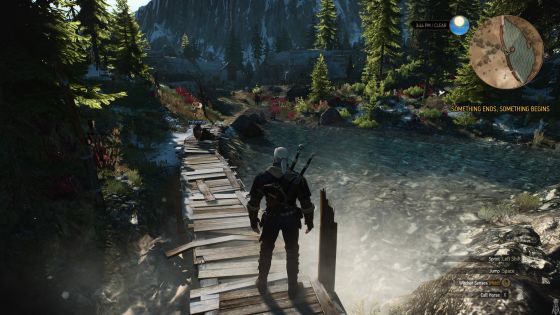
At any rate, as the basis for this review, I’ve completed everything except the following:
- A few land based locations in Skellige, including two places of power, due to a very annoying bug that prevented climbing from level 30 or so until it suddenly worked right near the end. Quite a few people have reported this bug, and worked around it by using cheats/mods to spawn items they could jump on, but I feel that’s too much hassle unless it’s on a main quest.
- Quite a few of the water based locations on Skellige. In short: I found the whole boat thing tedious, with a few exceptions (sailing to the haunted island in Velen for example). Sailing around for hours only to find a few lousy treasures with generic loot just isn’t my thing. I wasn’t a fan in Two Worlds 2 (not to be confused with The Witcher 2), and I’m not a fan here. If there’s going to be sailing, make it a proper ship like AC: Black Flag.
My character ended up at level 35 or so, and I doubt it’s possible to go much higher as it is, simply because the game stops rewarding XP for quests/monsters when they’re too far below Geralt, and there just aren’t that many high level quests/monsters. I’ve heard rumors that this is a bug, but it could also be a feature in order to prevent players from becoming too powerful. There is no scaling in TW3, and a level 40+ character would be immortal to just about everything even on the highest difficulty level.
It may be possible to get to such a level by doing things in a certain order (certain main quests are incredibly rewarding), but I simply see no reason to do that: Staying ahead of the curve is pretty easy at level 10+.
Gameplay
Even though The Witcher 3 has a lot in common with Skyrim and The Witcher 2, the way the game is played is actually quite different. The world may be similar in size to that of Skyrim, and the basic gameplay (combat, movement, signs/spells) is almost identical to The Witcher 2, but this is the first time we see Geralt actually doing what he’s supposed to be doing: Being a Witcher, traveling the world, taking on contracts, lifting curses and killing monsters. We’ve seen him do something similar in The Witcher 1 and 2, but never to this extent.
In The Witcher 3, this what you’ll be doing most of the time. It starts out in a fairly straight forward manner: Kill a griffon that’s terrorizing the locals in order to obtain some vital information. However, once that has been completed, Geralt is off to investigate various rumors in the far corners of the world, during which you’ll have plenty of opportunities to be a proper Witcher, earning gold and experience points along the way.
You’ll also be wanting to upgrade your gear, as some of the contracts involve some seriously hard hitting enemies. For the most part, loot is iterative, depending on your level, so every few levels you’ll likely find something that’s better than your current loot. However, the best high end gear consists mainly of special Witcher sets (no set bonus though), which can only be obtained through crafting. The ingredients are fairly easy to come by, especially later on, but the plans themselves must be found and taken to a master armorer or swordsmith. Finding the plans either requires a lot of exploration, or buying all the treasure maps from various vendors (this is by far the easier solution), which leads to treasure hunt quests.
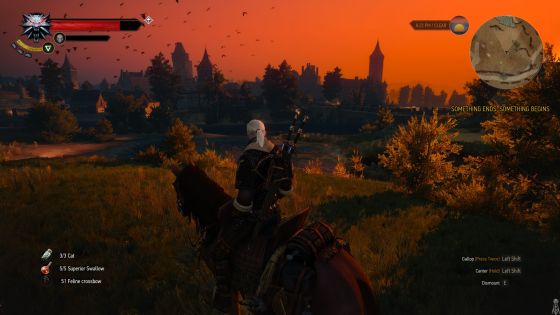
If you do want to explore every nook and cranny, Geralt now has access to Roach, his trusty horse. The horse can be summoned in just about any location (default button ‘X’ on the keyboard), and speeds up travel quite a bit. If you grow fond of horse travel, there are also horse races, which is a good way of getting improved saddles and what not for Roach. For the most part horse racing is pretty easy, as are the controls for the horse, but every now and then Roach will stop dead in his tracks because of some tiny pebble in the road, which could very well lead to a lost race and a keyboard thrown in the wall in frustration. Maybe that’s just me though. I should point out that while using the horse certainly speeds things up, it’s not mandatory, as there’s also fast travel between given markers (once discovered). Combine that with a bit of sprinting and it’s entirely possible to avoid using the horse, but I still recommend using it: Not only does riding along give you a greater sense of exploration, certain items you win from racing can be used to increase the inventory size, which is very convenient.
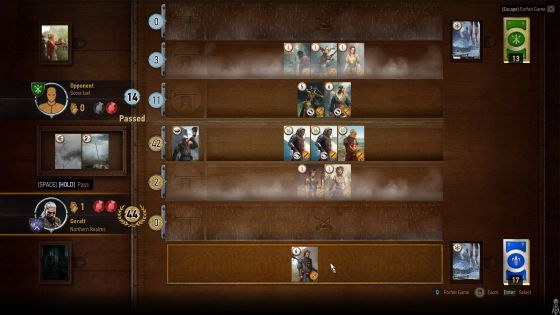
In addition to horse racing there’s also a new card game called Gwent. It can actually be quite addictive, reminding me of Arcomage from Might & Magic VII and VIII. The basic idea is this: You have one deck per faction (Nordlings, Nilfgaard, Scoia’tael and Monsters). Before each game, you get to choose a deck and set up your cards. The game is played for a maximum of three rounds, and in each round the winner is determined by the highest score. The best part of Gwent is actually not playing the game, but gathering cards: Every win over a new competitor yields a new card for your deck, and it takes quite a while to collect a perfect deck. Some cards can also be bought from innkeepers and so on, so it’s worth keeping an eye out for cards. If you can’t seem to beat an opponent, just return with a stronger deck later.
Story
Overall, the writing in TW3 is fantastic. Like I said in the introduction, it’s probably the first time I’ve experienced storytelling done right in such a massive game. That doesn’t mean it’s perfect, of course, as certain quest types become tedious (ca. at level 20) over time:
- Treasure Hunt: Pick up letter -> Read letter -> Go to area -> Witcher Senses -> Loot chest.
- Contract: Talk to witness or go to the area -> Witcher Senses -> Follow trail -> Kill beast.
However, the main quest and most side quests remain very, very interesting and entertaining throughout the game. In fact, they’re generally so good I don’t even mind getting no XP or worthwhile loot from them in the end, unlike the treasure hunts and contracts which felt like something of a chore near the end.
![]()
The only potential problem with the main quest is that it’s actually so good, with so many interesting characters, that it’s sometimes hard to put it away and go exploring. It’s hard to really explain why it’s such a good story without revealing too much, but it’s mainly the result of interesting characters, many of whom were present either in The Witcher 1 and 2, combined with intrigues and a sense of unraveling a mystery.
In fact, at one point in the game, after I had rescued a certain damsel in distress, I simply couldn’t stop playing through the main quest until I had almost completed it. Every time I thought I had figured everything out, something new and interesting appeared, and I just had to explore this new branch of the story. All of a sudden, I found myself at a very high level, having rendered the majority of the quests in my quest log obsolete, which may explain why completing them all felt a bit like a chore, especially since all I really wanted to do was to complete the main quest.
Gameworld: Exploration and Scope
The game world itself is massive, and for the most part varied: It contains massive swamps, mountains, fjords and fields. It also contains one of the best crafted cities I’ve ever seen an RPG: Novigrad. Novigrad reminds me of Baldur’s Gate, in that it’s overwhelming at first, but fun to explore once you get a sense of what’s what. There are dozens of interesting locations and people there, including some old friends, and I feel they’ve really managed to create a good atmosphere in the city. It feels alive, and it changes over time, so remember to revisit Novigrad frequently. New quests appear from time to time, based on certain events, and the vast majority of them are quite interesting.
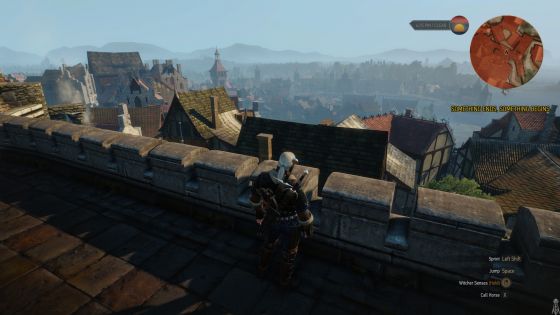
While Novigrad is massive, yet manageable, the rest of the game might actually be a bit too big (I said the same about DA: I, by the way). The main quest and side quests are all great, and should certainly not have been cut in any way, but for me there were too many contracts and locations that essentially felt repetitive and not worthwhile, especially since loot is somewhat iterative. In fact, no matter how awesome an item is, even if it is a blade called The Destroyer of Worlds, found in the ancient tomb of an Elven Sage, blessed by one of the Elder Blood, it will still get replaced by some junk off a bandit a few levels later (or found in some random chest). The only exceptions to that rule are the best, high end items that you can craft near the end of the game.
Also, herbs were somewhat pointless after the first few hours due to the new Alchemy system in which you can refill your potions while meditating. In fact, why were there herbs everywhere when they simply weren’t needed? Perhaps the system was changed near the end of the development to need less herbs? It seems a bit odd to see herbs appear everywhere when all we really need at that point is something called “alcohest” (a form of alcohol used to refill potions and bombs).
All that being said, one of the reasons why certain treasure hunts and contracts felt a bit like a chore, could be that I managed to out-level a good chunk of the content “by accident” because I got so drawn in by the main quest. Still, it is a bit of a shame to feel that way, as the world truly is masterfully crafted and well worth exploring. At any rate, it’s not a big issue, as most treasure hunts and contracts are optional and can safely be ignored. Almost all side quests and the main quest remained interesting the entire time, which is quite impressive in a huge game like this.
The one thing they could have changed regarding side quests is probably the spreading: There is no level scaling so, like in Gothic, you are likely to come across areas where you simply can’t do the quests. That doesn’t prevent you from obtaining the quests for that area though, and most likely in some area of your own level (Oxenfurt has a few quests around level 30 for example). The problem with that is that I kept forgetting who I was doing what for. Coming back for a quest 40 hours later happened several times, and I really had no idea what it’s all about, so I just traveled to the marker and completed it, without being able to appreciate what really went on.
Choices & Consequences
All in all, I would actually have preferred if they had cut down the scope a little in order to enhance the main quest or side quests even further, or to increase the amount of major C&C (choices and consequences). There is quite a bit of C&C in the game, and CDP proves yet again that they’re very good at such implementations, as the C&C are excellent. There’s just not enough of it, especially related to the save game import feature: The C&C in The Witcher 2 was among the best I’ve ever seen, with loads of political implications, yet hardly any the decisions have an impact in The Witcher 3. In fact, that’s probably my biggest disappointment with the game: I really enjoyed that aspect of The Witcher 2 and was hoping to see what they’d do with it. Ah well. If anyone’s going to get it right at some point, it is probably CDP, as their C&C implementation in The Witcher 2 really is second to none. Alpha Protocol, Arcanum and a few others are on a similar level, but I can’t think of any game that’s actually better.
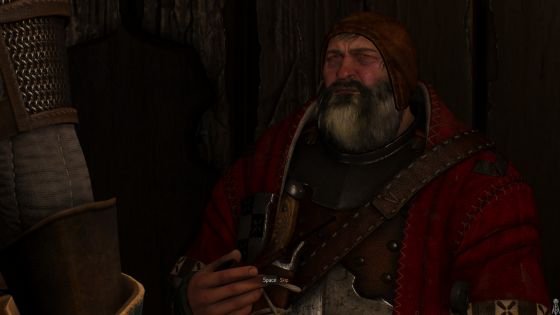
Verdict
This really is one of the best, or perhaps the very best, RPG to come out in years. It has some frustrating moments, but when it shines it shines brighter than most. The main quest is especially good, and by far the best I’ve seen in any kind of big, open world RPG. I can forgive a lot of faults when that is the case.
For anyone who hasn’t bought it yet, I can list a few possible minor turn offs:
- The annoyances mentioned above (lack of impact from the imported save game, iterative loot and certain repetitive quest types being the main offenders).
- It’s very dark and gritty. Depressing at times. This is a matter of taste, of course, and for me it’s sometimes a bit much.
- A bunch of crashes due to an NVidia driver issue. This can be solved by twiddling with the settings. Setting it to fullscreen instead of borderless window solved it for me.
- The minimap lacks a zoom function, so I felt I had to use the main map too often.
- Geralt takes way too much fall damage for a super strong, fast and durable mutant. He’s taking damage from jumps that even kids can do just fine.
- A few invisible walls, but only a few of them are annoying.
- A certain female sorcerer can be annoying. Why Geralt bothers, given his status and all his heroic feats, is beyond me.
- Trophies are not as interesting this time around. In fact, they’re flat out boring.
- Scandinavians beware: There are a lot of Scandinavian names in Skellige, and the pronunciation is hilarious.
Other than that it’s simple a matter of grabbing it. There are a few annoying bugs (such as the climbing one I mentioned), but given the sheer scope of the game I’m impressed I didn’t run into more issues. That being said, CDP tend to release an enhanced version of their games after a while, so anyone with a lot more patience than me could wait for that and get an even better version, but I really see no point in that given how fantastic the game already is.
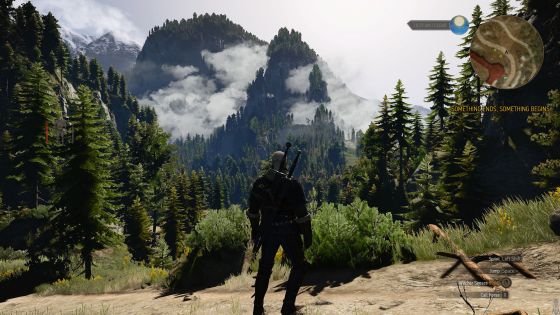
As always, if there’s anything in particular people want to know, just ask and I’ll fill in the blanks.
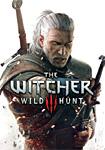
Information about
The Witcher 3: Wild HuntDeveloper: CD Projekt RED
SP/MP: Single-player
Setting: Fantasy
Genre: RPG
Combat: Real-time
Play-time: Over 60 hours
Voice-acting: Full
Regions & platforms
World
· Homepage
· Platform: PC
· Released: 2015-05-19
· Publisher: CD Projekt RED
More information
Summary
Pros
- Fantastic Storytelling
- Massive Gameworld, Love to Details
- Memorable Characters
- Many Great Questlines
- Gwent, Roach & Crafting
Cons
- Looting sometimes unrewarding, too much loot
- Contract quests a bit repetitive
- Import of The Witcher 2 saves has not much impact

